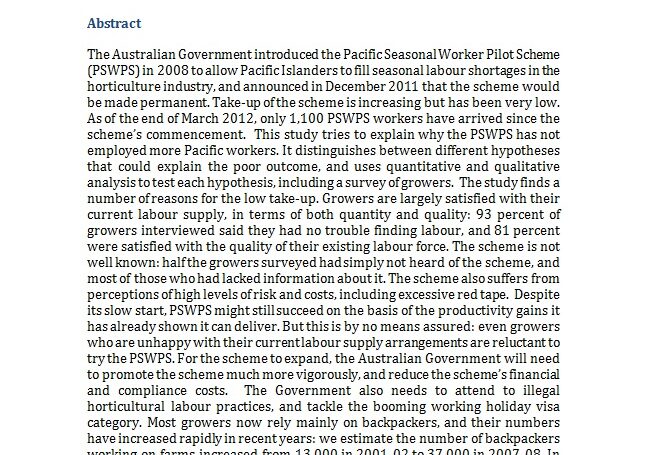Abstract:
The Australian Government introduced the Pacific Seasonal Worker Pilot Scheme (PSWPS) in 2008 to allow Pacific Islanders to fill seasonal labor shortages in the horticulture industry, and announced in December 2011 that the scheme would be made permanent. Take-up of the scheme is increasing but has been very low. As of the end of March 2012, only 1,100 PSWPS workers have arrived since the scheme’s commencement. This study tries to explain why the PSWPS has not employed more Pacific workers. It distinguishes between different hypotheses that could explain the poor outcome, and uses quantitative and qualitative analysis to test each hypothesis, including a survey of growers. The study finds a number of reasons for the low take-up. Growers are largely satisfied with their current labor supply, in terms of both quantity and quality: 93 percent of growers interviewed said they had no trouble finding labor, and 81 percent were satisfied with the quality of their existing labor force. The scheme is not well known: half the growers surveyed had simply not heard of the scheme, and most of those who had lacked information about it. The scheme also suffers from perceptions of high levels of risk and costs, including excessive red tape. Despite its slow start, PSWPS might still succeed on the basis of the productivity gains it has already shown it can deliver. But this is by no means assured: even growers who are unhappy with their current labor supply arrangements are reluctant to try the PSWPS. For the scheme to expand, the Australian Government will need to promote the scheme much more vigorously, and reduce the scheme’s financial and compliance costs. The Government also needs to attend to illegal horticultural labor practices, and tackle the booming working holiday visa category. Most growers now rely mainly on backpackers, and their numbers have increased rapidly in recent years: we estimate the number of backpackers working on farms increased from 13,000 in 2001-02 to 37,000 in 2007-08. In particular, the special preference which horticulture receives under the working holiday visa category should be removed. The policy challenges involved in making the PSWPS work should not be underestimated. Other avenues should also be explored for promoting Pacific migration, including adoption of New Zealand’s quota-based Pacific permanent migration schemes.
Suggested citation:
Hay, D. & Howes, S. 2012, ‘Australia’s Pacific Seasonal Worker Pilot Scheme: why has take-up been so low?’Discussion Paper No. 17, Development Policy Centre, Crawford School of Public Policy, Australian National University, Canberra.

